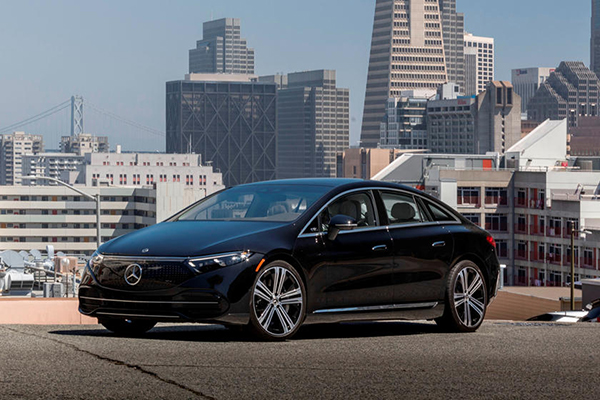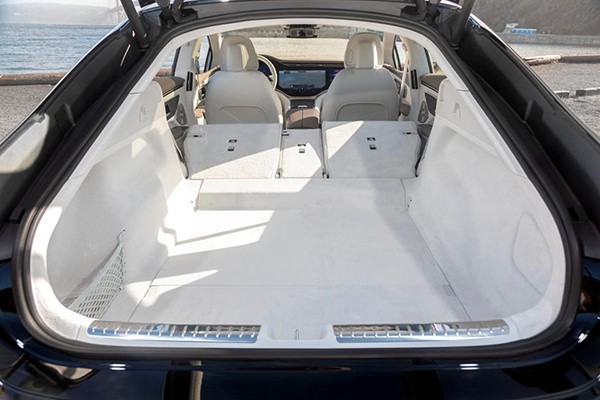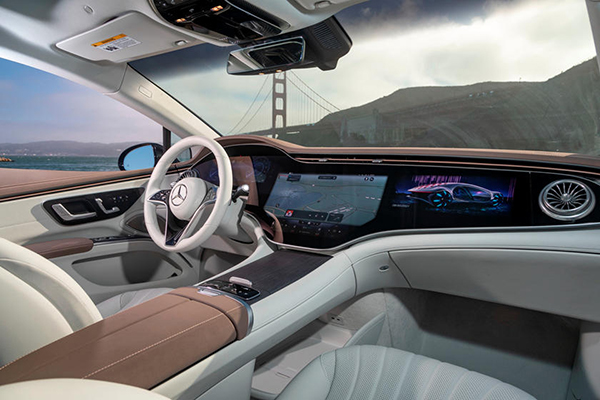Amongst all luxury vehicles, the Mercedes-Benz S-Class has set benchmarks for refinement, comfort, and technology. But after dominating the full-size luxury space for decades, Mercedes must now reach the pinnacle once again, this time without an internal combustion engine. Enter the 2022 Mercedes-Benz EQS Sedan, a vehicle that the German automaker is touting as the “S-Class of electric vehicles.” CarBuzz was given an early opportunity to drive the EQS around San Francisco, California, home to some of the largest technology companies in the world. What better place to evaluate one of the most tech-packed cars on the planet?
The EQS essentially fills a dual role with the gas-powered S-Class, acting as the flagship EV from the three-pointed star. It will eventually be joined by an EQS SUV, mid-size EQE Sedan, and EQE SUV, all underpinned by the same modular vehicle architecture, plus a more affordable EQB. This is our first taste of the Mercedes-EQ sub-brand here in the US, so Mercedes knows it must fire on all cylinders; or in this case, electrons.

Exterior Design: A Little Too Bold?
Though the EQS shares its “S” designation with the gas-powered S-Class, the two flagship sedans look nothing alike. Mercedes calls the EQS a “one bow” design, with a single line curving across the coupe-like silhouette. It’s three inches shorter than the S-Class, but sits wider and taller. The A-pillar is pushed farther forward, giving the EQS a cab-forward design that looks straight out of a sci-fi movie. Meanwhile at the back, the C-pillar is pushed back, providing more space for passengers. The design is certainly futuristic, but does it look premium? We aren’t sold, and our social audience seems in agreement.
We were expecting to receive more attention while a brand-new six-figure luxury car that isn’t on sale yet, but no one seemed to take notice of the EQS. Perhaps the shape will take some getting used to, but upon first impressions, the side profile looks more like a jellybean than a $100,000 luxury flagship. We would have preferred to see Mercedes give the EQS a more traditional shape. A longer hood is typically indicative of a more expensive car, which is why the decision to go cab-forward here seems like a miss.
Though we weren’t enthralled with the overall shape, the EQS has plenty of cool exterior details. For example, it rides on wheels ranging from 20 to 22 inches in size, with some futuristic patterns helping to achieve the car’s industry-leading .201 drag coefficient. Our eyes may not love the EQS, but that sleek shapes works wonders in a wind tunnel. Other cool details include a Black Panel radiator grille with connected digital light headlamps stretching above it. Similarly, the taillights are one connected bar across the back with a cool 3D helix design.
Like many electric cars, the EQS features flush door handles that pop out when you stroke your finger across them. Unfortunately, we had some difficulty getting them to work, later discovering that they require a gentle hand with a slow movement. Recessed door handles would have been preferred here. At least on the top EQS trim, the door automatically opens and closes, so there’s no need to interact with the handle.
Powertrain: Wafting Performance
Mercedes will initially offer the EQS with two powertrain options, later introducing a faster AMG variant to the mix. The standard EQS 450+ employs a single rear electric motor producing 329 horsepower and 419 lb-ft of torque. This drivetrain doesn’t feel rapid, but consistently shoves the EQS to 60 mph in a relaxed 5.9 seconds. Buyers who crave more immediate acceleration will want to opt for the EQS 580 4MATIC. This upgraded model adds a second electric motor on the front axle, creating all-wheel drive. Together, the two electric motors produce 516 hp and 631 lb-ft, cutting the 0-60 time down to 4.1 seconds.
The EQS 580 feels more immediate, and the acceleration takes longer to taper off. While the 450+ isn’t capable of shoving passengers into their seats, the 580 can nudge occupants into their pillow-covered headrests. Both models have a claimed top speed of 130 mph, but the EQS 580 will achieve it much quicker while providing more effortless passing power, especially at highway speeds. If neither EQS model sounds quick enough, the upcoming AMG model will produce 649 hp (751 hp with overboost) and hit 60 mph in 3.4 seconds.

Driving Impressions: Silent Sofa
We’ll forgive the EQS for its quirks, because this EV is spectacular to drive. In many ways, it far exceeds even the heralded S-Class in comfort, refinement, and agility. The standard air suspension makes short work of rough roads, letting the EQS float along like a silent sofa on wheels. Sport mode makes the suspension significantly firmer, without completely ruining the ride comfort. A rear-axle steering system comes standard, giving this 207-inch-long car the turning radius you’d expect from a subcompact A-Class, making it easy to park and nimble on a back road. We loved the electromechanical steering, which feels natural and direct, and can change weights based on the drive mode.
This is no sports car, but we came away stunned by how infallible the EQS felt on San Francisco’s mountain roads. With the battery mounted low in the floor and no heavy engine sitting up front, this car has neutral, near-perfect handling balance. We pitched the EQS into a decreasing radius, uphill on-ramp – a turn that would embarrass a lesser chassis – and the car zipped around as if it were nothing. It bodes very well for the AMG version.
On anything less than a pothole cratered street, the EQS wafts along silently, protecting its occupants from the outside world. Drivers who prefer a sound when they mash the throttle can activate one of two soundscapes called Silver Waves and Vivid Flux. Silver Waves produces a low hum like a refined combustion engine, while Vivid Flux generates more high-pitched futuristic noises that reminded us of a Formula E car going through the tunnel in Monaco. A third soundscape called Roaring Pulse will be available through an OTA update, which was not yet available to sample.
We had only one major complaint about the EQS driving experience; the brakes. Like all electric cars, the EQS uses regenerative braking technology to recapture energy into the battery. There are four modes controlled by the steering wheel-mounted paddles, ranging from coasting to heavy regen. Unlike some competitors, the regen does not bring the EQS to a full stop, so it can’t do one-pedal driving. We also found the brake pedal feel highly inconsistent when it transitioned from regeneration to the pads. In some cases, the pedal will even pull away from your foot during this transition, creating an unnerving experience.
Range: Making EV Ownership Easier
Both EQS variants arrive sporting one of the largest batteries we’ve seen in an EV with 107.8 kWh of usable capacity. This massive battery results in impressive EPA-estimated ranges of 350 miles for the EQS 450+, and 340 miles for the EQS 580 4MATIC. That’s about 50 miles less than the longest-range Tesla Model S and a whopping 170 miles off the top Lucid Air, but it’s more than the Audi e-tron GT, BMW i4, and Porsche Taycan. Even with this level of comfort, we’d want to take a break to charge and stretch after 350 miles.
With regards to charging, Mercedes is making the process easier than ever, depending on where you get your juice from. The car can charge at a a peak rate of 200 kW, going from 10-80% in just 31 minutes on a DC fast charger. Mercedes will even throw in complimentary 30-minute charge sessions for two years through Electrify America, though we doubt electricity costs are a top concern at this price level.
On a level 2 wallbox, it will take 11.5 hours to go from 10% to a full charge.
Some competitors can charge quicker, but a new “Plug & Charge” feature allows owners to plug in and charge automatically without pulling out a credit card or third party apps. This should alleviate one of the biggest pain points with public charging, but this feature only works on Electrify America for now. Using the “Mercedes me Charge” feature on the navigation system, drivers can check how many plugs are available and the station’s peak charging rate before using up valuable range to get there. This is the best integration of charging stations that we’ve seen on an OEM navigation system.

Interior Design: Comfort Tech
This being the “S-Class of EVs,” Mercedes saw it fit to gift the EQS with dazzling technology. The centerpiece is the new Hyperscreen (optional on the 450+ and standard on the 580), comprising three individual screens housed under a single glass sheet. It measures 56 inches wide with a 12.3-inch driver display, 17.7-inch central display, and 12.3 inch passenger display. The driver display shows the gauges, and can also transform into a full color map with an available augmented reality HUD making sure you never miss an exit. Drivers can change what’s on the screen using the touch-capacitive controls on the wheel.
The central display touch operated, powered by Mercedes’ MBUX infotainment software. A new Zero Layer menu format places the map in the background with frequently used controls in the foreground. The system will learn the driver’s behavior patterns, and suggest items such as the massage seats, navigation destinations, or raising the air suspension for a steep driveway after getting to know you.
The passenger display can mirror anything the central screen can do, allowing the passenger to set the GPS, change the radio, and be the ideal co-pilot.
We wanted to fall in love with the Hyperscreen, but in practice, it didn’t seem to serve any additional purpose over the standard 12.8-inch screen that’s shared with the S-Class, especially if you don’t have a passenger. If the Hyperscreen seems overwhelming, the base EQS 450+ is available without it. Unlike the Jeep Grand Wagoneer, which also puts a screen in front of the passenger, the EQS doesn’t have Amazon Fire TV integration where passengers can watch streaming services like Netflix or Hulu. This is one area where the EQS feels behind the industry with regard to infotainment.
We were also less expecting more from the standard Burmester 3D surround sound. It packs 15 speakers with a 710-watt output, but it sounded a bit flat when listening to music at full blast. The conventional S-Class features a far more impressive 4D Burmester system with 30 speakers, with resonators in the seats that vibrate with the music. In some ways, it feels as though Mercedes wanted to keep the EQS below the S-Class, rather than give it all the best technology.

Rear Seat & Cargo Space: Liftback Is Best
Moving towards the back, the EQS is both inferior and superior to the S-Class, depending on what’s important. Mercedes hasn’t provided exact specifications on interior space just yet, but the rear accommodations pale in comparison to the S-Class. We felt the back rests were too firm and positioned too upright, while the seat base was tilted up in an uncomfortable position, putting our knees too close to our chest. It’s very unbefitting of an S-Class-level vehicle. There is an optional power-reclining rear seat with heating, ventilation, and massaging, but we were not able to test it. And though there are press photos showing rear entertainment screens, those won’t be available in the US market. The best seat in the house here is up front.
As for the cargo space, the EQS outshines the S-Class thanks to its liftback design. Like an SUV, trunk opens up to a massive area connected to the cabin, which can grow even larger by folding the rear seats in a 40:20:40 split. Mercedes confirmed that opting for the powered rear seat doesn’t hamper practicality. Though the rear trunk is massive, there’s no frunk like some competing EVs.
Pricing & Trims: The Frugal Flagship
Much to our surprise, the 2022 EQS is less expensive than its gas-powered counterpart. The EQS 450+ Premium starts at $102,310 (not including $1,050 destination), plus there’s $7,500 of federal tax credit available, although not at the time of purchase. By comparison, the six-cylinder S500 4MATIC costs $109,800, though it does have nearly 100 hp more plus standard AWD. Stepping up to the Exclusive trim isn’t a huge price increase at $105,710, nor is the top Pinnacle trim for $108,510.
In contrast, opting for the dual-motor EQS 580 4MATIC require a significant price premium. The EQS 580 Premium starts at $119,110, making it nearly $17,000 more than the base 450+. Like the base powertrain, there’s not a huge price discrepancy for the upper trim levels, with the Exclusive starting at $122,510 and the Pinnacle at $125,310. If you can live without the AWD and additional power, we’d opt for the EQS 450+ Pinnacle, which still rings in $10,6000 below the base ESQ 580.

Verdict: An EV Flagship With Some Edges
After spending 100 years perfecting the ICE vehicle, Mercedes now has to rethink the car. This will take time. Reaching the pinnacle doesn’t happen overnight, but Mercedes feels like it’s starting from the highest point with the EQS. It’s made some bold moves with the EQS and most of them paid off. We think a more conventional design would have helped bring in more EV-apprehensive buyers, but Mercedes wanted the EQS to scream “the future is now!”
If you can get around the jellybean styling, the EQS offers the most opulent cabin we’ve seen in an EV with some of the best tech around. We still prefer the S-Class in some ways, but out on the road, the EQS proves why electricity is such a compelling power source. The S-Class still outshines the EQS as a chauffeur vehicle with a more luxurious back seat, but the EQS is the more effective cargo hauler.
As for where the EQS stacks up in the luxury EV segment, we only see one key competitor on the board, and it’s not Tesla. A Model S is quicker and goes further than the EQS, but Mercedes interior is far nicer than the Tesla. The two don’t belong in the same league. Mercedes will soon face competition from the BMW i7, but its most immediate threat is the Lucid Air.
We haven’t driven the Lucid yet but it should draw customers in with a lower starting price, longer range, and more available power. Lucid faces an uphill battle to sway buyers into a start-up company versus an automaker that’s been around for over 100 years, but as we’ve seen from Tesla, this mission is far from impossible. As least for now, we can say the Mercedes EQS is the most luxurious EV we’ve ever tested.
Mercedes-Benz EQS Sedan Review By Carbuzz
10/10/2021
8 Comments
Mercedes-Benz | Mercedes-AMG
Click to rate this post
[Total: 1 Average: 5]
Louisabare
читать [url=https://vodkabet-vbet.site/]vodkabet новый сайт[/url]